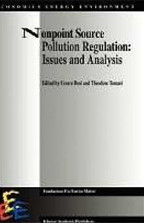Nonpoint source pollution regulation: issues and analysis

01.06.1994
Cesare Dosi, Theodore Tomasi
Kluwer Academic, Series on Economics, Energy, Environment
The book provides an overview of advances in the theoretical analysis of
NPS pollution and regulation from an economic perspective. Besides
specific policy recommendations, a common theme in the essays is the
attempt to suggest regulatory approaches starting from the recognition
of the problems of incomplete information encountered when dealing with
NPS problems. Such problems, which can be traced back to the difficulty
of identifying sources and measuring individual discharges, imply that
rather than monitoring emissions at source, alternative solutions have
to be found to set regulatory policy instruments. In this sense, besides
problems classified in the technical literature as NPS pollution many
of the considerations are also applicable to phenomena labelled as
point-source problems. However, despite the availability of technical
means for measuring the volume and quality of emissions, wide-spread and
continuous monitoring of individual discharges is not economically
feasible. Thus alternative ways of establishing cause and effect links
between economic activities and observed environmental quality
impairments are required.
Contributors: D. G. Abler, J. Braden, C. Dosi, R.
Govindasamy, J. A. Herriges, J-J. Laffont, M. Moretto, K. Segerson, J.
Shogren, J. Shortle, T. Tomasi, A. Xepapadeas, A. Weis
The book provides an overview of advances in the theoretical analysis of NPS pollution and regulation from an economic perspective. Besides specific policy recommendations, a common theme in the essays is the attempt to suggest regulatory approaches starting from the recognition of the problems of incomplete information encountered when dealing with NPS problems. Such problems, which can be traced back to the difficulty of identifying sources and measuring individual discharges, imply that rather than monitoring emissions at source, alternative solutions have to be found to set regulatory policy instruments. In this sense, besides problems classified in the technical literature as NPS pollution many of the considerations are also applicable to phenomena labelled as point-source problems. However, despite the availability of technical means for measuring the volume and quality of emissions, wide-spread and continuous monitoring of individual discharges is not economically feasible. Thus alternative ways of establishing cause and effect links between economic activities and observed environmental quality impairments are required.
Contributors: D. G. Abler, J. Braden, C. Dosi, R. Govindasamy, J. A. Herriges, J-J. Laffont, M. Moretto, K. Segerson, J. Shogren, J. Shortle, T. Tomasi, A. Xepapadeas, A. Weis
